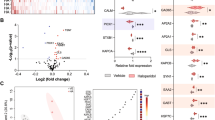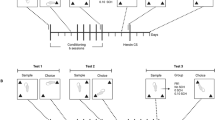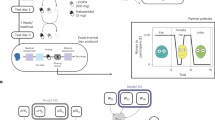Abstract
The cataleptic behavior induced by the dopamine D1 antagonist SCH 23390 (SCH) has proven to be a useful assay for investigating the sensitivity of D1-like dopamine receptor-mediated effects during chronic drug administration. A fundamental flaw in most of these studies may be the involvement of the “repeated measures effect,” a behavioral phenomenon well demonstrated for neuroleptic-induced catalepsy but not yet investigated for dopamine D1 antagonists. In this study, mice exposed for various sessions to the bar test presented a strong sensitization to the cataleptic behavior induced by repeated SCH treatment. Conversely, single tested animals exhibited a trend toward decreased catalepsy after repeated SCH treatment, which was in line with the development of a D1-like dopamine receptor supersensitivity suggested by an increase in SKF 38393-induced grooming behavior. Surprisingly, a challenge intraperitoneal saline injection increased the cataleptic behavior of single tested mice after long-term SCH treatment. This “injection-conditioned ” was also observed after repeated treatment with the dopamine D2 antagonists, haloperidol and metoclopramide. While these findings seem to explain some important contradictory data in the literature, they provide a new and simple animal model of the placebo effect.
Similar content being viewed by others
Log in or create a free account to read this content
Gain free access to this article, as well as selected content from this journal and more on nature.com
or
References
Amir S, Brown ZW, Amit Z, Ornstein K . (1981): Body pinch induces long lasting cataleptic like immobility in mice: Behavioral characterization and the effect of naloxone. Life Sci 28 (10): 1189–1194
Antelman SM, Kocan D, Edwards DJ, Knopf S, Perel JM, Stiller R . (1986): Behavioral effects of a single neuroleptic treatment grow with the passage of time. Brain Res 385 (1): 58–67
Asper H, Baggiolini M, Burki HR, Lauener H, Ruch W, Stille G . (1973): Tolerance phenomena with neuroleptics catalepsy, apomorphine stereotypies and striatal dopamine metabolism in the rat after single and repeated administration of loxapine and haloperidol. Eur J Pharmacol 22 (5): 287–294
Axelrod J, Reisine TD . (1984): Stress hormones: Their interaction and regulation. Science 224 (4648): 452–459
Barnes DE, Robinson B, Csernansky JG, Bellows EP . (1990): Sensitization versus tolerance to haloperidol-induced catalepsy: Multiple determinants. Pharmacol Biochem Behav 36 (4): 883–887
Brown J, Handley SL . (1980): The development of catalepsy in drug-free mice on repeated testing. Neuropharmacology 19 (7): 675–678
Campbell A, Baldessarini RJ . (1981): Tolerance to behavioral effects of haloperidol. Life Sci 29 (13): 1341–1346
Carey RJ . (1992): Pavlovian conditioning of L-dopa induced movement. Psychopharmacology 107(2–3):203–210
Christensen AV, Arnt J, Hyttel J, Larsen JJ, Svendsen O . (1984): Pharmacological effects of a specific dopamine D1 antagonist SCH 23390 in comparison with neuroleptics. Life Sci 34 (16): 1529–1540
Creese I, Chen A . (1985): Selective D1 dopamine receptor increase following chronic treatment with SCH 23390. Eur J Pharmacol 109 (1): 127–128
Di Chiara G . (1995): The role of dopamine in drug abuse viewed from the perspective of its role in motivation. Drug Alcohol Depend 38 (2): 95–137
Dijk S, Krugers HJ, Korf J . (1991): The effect of teophylline and immobilization stress on haloperidol-induced catalepsy and on metabolism in the striatum and hippocampus, studied with lactograph. Neuropharmacology 30 (5): 469–473
Ezrin-Waters C, Seeman P . (1977): Tolerance of haloperidol catalepsy. Eur J Pharmacol 41 (3): 321–327
Ferré S, Guix T, Prat G, Jane F, Casas M . (1990): Is experimental catalepsy properly measured? Pharmacol Biochem Behav 35 (4): 753–757
Frussa-Filho R, Otoboni JR, Uema FT, Palermo-Neto J . (1992): Effects of age and isolation on the evolution of catalepsy during chronic haloperidol treatment. Braz J Med.Biol Res 25 (9): 925–928
Frussa-Filho R, Palermo-Neto J . (1988): Effects of single and long-term metoclopramide administration on open-field and stereotyped behaviour of rats. Eur J Pharmacol 149 (3): 323–329
Frussa-Filho R, Palermo-Neto J . (1990): Effects of single and long-term administration of sulpiride on open-field and stereotyped behaviour of rats. Braz J Med Biol Res 23 (5): 463–472
György L, Pfeifer KA, Hajtman B . (1969): Modification of certain central nervous effects of haloperidol during long-term treatment in the mouse and rat. Psychopharmacologia (Berl) 16 (3): 223–233
Hansen TE, Hoffman WF . (1997): Drug-induced Parkinsonism. In: Yassa R, Nair NPV, Jeste DV (eds). Neuroleptic-Induced Movement Disorders. New York: Cambridge University Press, pp 341–380
Hess EJ, Albers LJ, Le H, Creese I . (1986): Effects of chronic SCH 23390 treatment on the biochemical and behavioral properties of D1 and D2 dopamine receptors: potentiated behavioral responses to a D2 dopamine agonist after selective D1 dopamine receptor up-regulation. J Pharmacol Exp Ther 238 (3): 846–854
Hess EJ, Norman AB, Creese I . (1988): Chronic treatment with dopamine receptor antagonists: behavioral and pharmacologic effects on D1 and D2 dopamine receptors. J Neurosci 8 (7): 2361–2370
Hillegaart V, Ahlenius S, Magnusson O, Fowler CJ . (1987): Repeated testing of rats markedly enhances the duration of effects induced by haloperidol on treadmill locomotion, catalepsy and a conditioned avoidance response. Pharmacol Biochem Behav 27: 159–164
Hiroi N, White NM . (1989): Conditioned stereotypy: behavioral specification of the UCS and pharmacological investigation of the neural change. Pharmacol Biochem Behav 32 (1): 249–258
Hoffman DC, Beninger RJ . (1988): Conditional tolerance to haloperidol-induced catalepsy: Striatal dopamine receptor supersensitivity is a possible explanation. Psychopharmacology (Berl) 95 (1): 142–145
Hyttel J . (1983): SCH 23390—the first selective dopamine D1 antagonist. Eur J Pharmacol 91 (1): 153–154
Ikemoto S, Glazier BS, Murphy JM, McBride WJ . (1997): Role of dopamine D1 and D2 receptors in the nucleus accumbens in mediating reward. J Neurosci 17 (21): 8580–8587
Iwata S, Izumi K, Shimizu T, Fukuda T . (1989): Effects of repeated testing on the incidence of haloperidol-induced catalepsy in mice. Pharmacol Biochem Behav 33 (3): 705–707
Lipska BK, Jaskiw GE, Braun AR, Weinberger DR . (1995): Prefrontal cortical and hippocampal modulation of haloperidol-induced catalepsy and apomorphine-induced stereotypic behaviors in the rat. Biol Psychiatry 38: 255–262
Kinon BJ, Kane JM . (1989): Difference in catalepsy response in inbred rats during chronic haloperidol treatment is not predictive of the intensity of behavioral hypersensitivity which subsequently develops. Psychopharmacology (Berl) 98 (4): 465–471
Klemm WR . (1993): The catalepsy of blocked dopaminergic receptors. Psychopharmacology (Berl) 111 (2): 251–253
Lappalainen J, Hietala J, Syvälahti E . (1989): Differential tolerance to cataleptic effects of SCH 23390 and haloperidol after repeated administration. Psychopharmacology (Berl) 98 (4): 472–475
Lynch JJ, Stein EA, Fertziger AP . (1976): An analysis of 70 years of morphine classical conditioning: Implications for clinical treatment of narcotic addiction. J Nerv Mental Disease 163 (1): 47–58
Miller R, Wickens JR, Beninger RJ . (1990): Dopamine D1 and D2 receptors in relation to reward and performance: A case for the D1 receptor as a primary site of therapeutic action of neuroleptic drugs. Progr Neurobiol 34 (2): 143–183
Mizuki Y, Ushijima I, Yamada M . (1996): Effects of chronic methamphetamine on SCH 23390- or haloperidol- induced catalepsy, and effects of coadministration of SCH 23390 or haloperidol in mice. Pharmacol Biochem Behav 53 (2): 437–440
Moller Nielsen I, Fjalland B, Pedersen V, Nymark M . (1974): Pharmacology of neuroleptics upon repeated administration. Psychopharmacologia (Berl) 34 (2): 95–104
Molloy AG, Waddington JL . (1984): Dopaminergic behavior stereospecifically promoted by the D1 agonist R-SKF 38393 and selectively blocked by the D1 antagonist SCH 23390. Psychopharmacology 82 (4): 409–410
Parashos SA, Marin C, Barone P, Kapitzoglou-Logothetis V, Chase TN . (1990): Effect of chronic D1 and/or D2 dopamine antagonist treatment on SKF 38393-induced non-stereotyped grooming. Psychopharmacology 102 (3): 411–413
Pavlov IP . (1927): Conditioned Reflexes. London, Oxford University Press
Pickens RW, Crowder WF . (1967): Effects of CS-US interval on conditioning of drug response, with assessment of speed of conditioning. Psychopharmacologia 11 (1): 88–94
Rocha JB, Santos JE, Rocha LK, Kleinpaul ER . (1997): Undernutrition during suckling changes the sensitivity to haloperidol and chlorpromazine in two behavioural measures in weaning rats. Pharmacol Toxicol 81 (3): 114–123
Sanberg PR . (1980): Haloperidol-induced catalepsy is mediated by postsynaptic dopamine receptors. Nature 284 (5755): 472–473
Sanberg PR, Bunsey MD, Giordano M, Norman AB . (1988): The catalepsy test: its ups and downs. Behav Neurosci 102: 748–759
Schiff SR, Bridger WH, Sharless NS, King JJ . (1980): Conditioning using drugs affecting dopaminergic systems as unconditioned stimuli: Behavioral and biochemical evidence. Psychopharmacol Bull 16: 24–27
Schiff SR . (1982): Conditioned dopaminergic activity. Biol Psychiatry 17 (2): 135–155
Seeman P . (1980): Brain dopamine receptors. Pharmacol Rev 32: 229–313
St Jean A, Donald MW, Ban TA . (1964a): Uses and abuses of antiparkinsonian medication. Am J Psychiatry 120: 801–803
St Jean A, Donald M, Ban TA . (1964b): Interchangeability of Antiparkinsonian medication. Am J Psychiatry 120: 1189–1190
Stanley ME, Glick SD . (1976): Interaction of drug effects with testing procedures in the measurement of catalepsy. Neuropharmacology 15 (7): 393–394
Suchman AL, Ader R . (1992): Classic conditioning and placebo effects in crossover studies. Clin Pharmacol Ther 52 (4): 372–377
Tilson HA, Rech RH . (1973): Conditioned drug effects and absence of tolerance to d-amphetamine induced motor activity. Pharmacol Biochem Behav 1: 149–153
Undie AS, Friedman E . (1988): Differences in the cataleptogenic actions of SCH 23390 and selected classical neuroleptics. Psychopharmacology 96: 311–316
Ushijima I, Mizuki Y, Yamada M . (1995): Development of tolerance and reverse tolerance to haloperidol- and SCH 23390-induced cataleptic effects during withdrawal periods after long-term treatment. Pharmacol Bioch Behav 50 (2): 259–264
Vital MABF, Frussa-Filho R, Palermo-Neto J . (1995): Effects of monosialoganglioside on dopaminergic supersensitivity. Life Sci 56 (26): 2299–2307
Wise RA, Bozarth MA . (1987): A psychomotor stimulant theory of addiction. Psychol Reviews 94: 469–492
Wise RA, Rompre P-P . (1989): Brain dopamine and reward. Annu Rev Psychol 40: 191–225
Acknowledgements
This research was supported by a fellowship from Fundação de Amparo a Pesquisa do Estado de São Paulo (FAPESP—Proc. 97/12915–9 and Proc. 99/00526–3) and from Conselho Nacional de Desenvolvimento Cientıacute;fico e Tecnológico (CNPq—Proc. 522975/95–0).
Author information
Authors and Affiliations
Rights and permissions
About this article
Cite this article
Chinen, C., Frussa-Filho, R. Conditioning to Injection Procedures and Repeated Testing Increase SCH 23390-Induced Catalepsy in Mice. Neuropsychopharmacol 21, 670–678 (1999). https://doi.org/10.1016/S0893-133X(99)00061-5
Received:
Revised:
Accepted:
Issue date:
DOI: https://doi.org/10.1016/S0893-133X(99)00061-5



